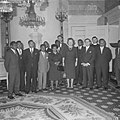|
New Guinea Council
The New Guinea Council (Dutch: Nieuw-Guinea Raad) was a unicameral representative body formed in the Dutch overseas territory of Netherlands New Guinea in 1961. HistoryNetherlands New GuineaPrior to the formation of the New Guinea Council, there existed a Council of Directors, which consisted of the heads of government departments. Dutch authorities initially began to establish local government bodies such as village councils and regional councils. The New Guinea Council was inaugurated on 5 April 1961 with 28 council members, 16 of whom had been elected in elections held during January 1961. The council's inauguration was attended by representatives from Australia, France, the Netherlands, New Zealand, the United Kingdom and other Pacific Forum nations with exception of the United States.[1][2] The council was requested to make its wishes on self-determination known within a year.[3] During an emergency session the council drafted a national manifesto and symbols including the Morning Star flag for a new national identity to be known as "West Papua".[4] United Nations Administered West New GuineaFollowing the August 1962 New York Agreement between the governments of the Netherlands and Indonesia, the administration of Western New Guinea was assumed by the United Nations Temporary Executive Authority (UNTEA) on 1 October 1962. The New Guinea Council was reconvened by United Nations administrator on 4 December 1962 and members took new oaths of office, swearing allegiance to UNTEA.[5] The council was disbanded when Western New Guinea was handed over to Indonesia on 1 May 1963. Council officialsFrits Sollewijn Gelpke was Council Chairman and Nicolaas Jouwe was Vice-Chair. J. W. Trouw was the Clerk of the Council. Council buildingA council building was built in Hollandia from 1960 to 1961 and used until the abolition of the council in 1962. Currently the building houses the regional legislature of Papua, People's Representative Council of Papua.[6] Gallery
See alsoReferences
|
||||||||||||||||||||||||||||








